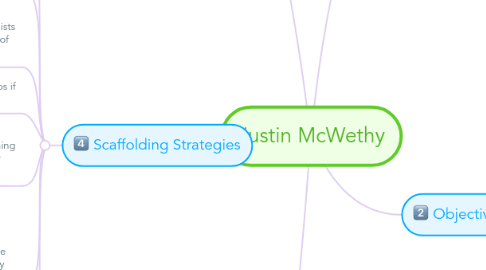
1. Scaffolding Strategies
1.1. Students are free to chose resources that they are familiar with
1.2. Prior to students collecting their own resources, I will provide modeling examples of the types of resources to use and how to document the information
1.2.1. As students collect their sources I will require that they submit their sources with a written description of what information the source is providing as a way for me to assess their progress and provide feedback
1.2.1.1. There will be three rounds of source collection so students are getting lots of practice searching and collecting sources for specific information with feedback provided between each round
1.3. As we move through the unit we will have discussion, think-pair-share, and visual aid lists of ideas generated from the class for each of the three source collection topics.
1.3.1. At the end of the class period or day I can do a sentence starter where students answer the question: Today in class I learned __________ about the use of water as a natural resource.
1.3.1.1. These sentences can be read aloud in class for all students to hear as further reinforcement of the concepts
1.4. Students will be able to work in small groups if they need to as they collect their sources
1.5. I will be available and floating the classroom/library as the students are searching for their sources to answer any questions or help with finding information
1.6. Objective 5 allows students to put all the information they collected to practice by applying a scientific idea to their home life.
1.6.1. As a class we will identify possible strategies that could be used at home and each student will be able to choose their own
1.6.2. As the teacher I will be doing the project along with the students to help model
1.6.3. As the data collection at home is going on we will be discussing our progress in class
1.6.3.1. I will be collecting the data sheets between weeks to assess and provide feedback
1.7. As a summative assessment for all of the objectives there will be a poster presentation from small groups about the information they collected and the findings from their data collection at home over the two weeks
1.7.1. I will be providing an example of what a possible poster could look like to the class as a visual aid and expectation
2. Big Ideas
2.1. Science and Engineering Practices
2.1.1. Obtaining, Evaluating, and Communicating Information
2.2. Disciplinary Core Ideas
2.2.1. Human Impacts on Earth Systems
2.3. Cross Cutting Concepts
2.3.1. Science Addresses Questions about the Natural and Material World
3. Student Factors
3.1. Readiness Level
3.1.1. This is a unit that would be used after students have learned the routines and procedures of the classroom. It requires independent work, small group work, over a longer period of time. This is not a project I would start the year with.
3.2. Prior Knowledge
3.2.1. Because this project would happen later in the year the students will be knowledgable of project based learning methods.
3.2.2. Students will also have just learned about water systems, amount, cycle, distribution, and availability prior to this project.
3.3. Differentiation
3.3.1. Many of the strategies for scaffolding the lesson will provide support for students will extra needs

